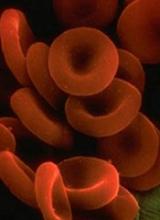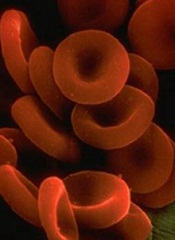User login
The US Food and Drug Administration (FDA) has approved ferric citrate (Auryxia) to treat iron-deficiency anemia in adults with chronic kidney disease (CKD) who are not on dialysis.
Ferric citrate was originally approved by the FDA in September 2014 for the control of serum phosphorus levels in patients with CKD who require dialysis.
The full prescribing information for the drug is available at www.Auryxia.com.
“We are pleased with the broad indication permitted by the FDA, as a first-line treatment option for adults with iron-deficiency anemia and chronic kidney disease not on dialysis,” said John Neylan, MD, senior vice president and chief medical officer of Keryx Biopharmaceuticals, Inc., the company marketing ferric citrate.
“Physicians and their patients now have a new treatment option to help manage a serious complication of this complex disease.”
The new approval of ferric citrate was based on results from a 24-week, placebo-controlled, phase 3 trial. Results from this trial were published in the Journal of the American Society of Nephrology in January.
The trial enrolled 234 adults with stage 3-5, non-dialysis-dependent CKD and iron-deficiency anemia. Patients had hemoglobin levels between 9.0 g/dL and 11.5 g/dL and were intolerant to or had an inadequate response to prior treatment with oral iron supplements.
The starting dose of ferric citrate was 3 tablets per day, taken with meals. The mean dose was 5 tablets per day. Patients were not allowed to receive any intravenous or oral iron or erythropoiesis-stimulating agents.
Significantly more patients in the ferric citrate arm than the placebo arm had increases in hemoglobin levels of at least 1 g/dL at any point during the trial’s 16-week efficacy period—52.1% (61/117) and 19.1% (22/115), respectively (P<0.001).
Likewise, significantly more patients in the ferric citrate arm than the placebo arm had a sustained increase in hemoglobin of at least 0.75 g/dL over any 4-week period during the trial—48.7% (n=57) and 14.8% (n=17), respectively (P<0.001).
Serious adverse events occurred in 12.0% of patients in the ferric citrate arm and 11.2% of patients in the placebo arm. There were 2 treatment-emergent deaths in the ferric citrate arm (and none in the placebo arm), but they were not considered drug-related.
The most common (≥5%) treatment-emergent adverse events in patients who received ferric citrate were diarrhea (20.5%), constipation (18.8%), discolored feces (14.5%), nausea (11.1%), abdominal pain (6.0%), and hyperkalemia (6.8%). ![]()
The US Food and Drug Administration (FDA) has approved ferric citrate (Auryxia) to treat iron-deficiency anemia in adults with chronic kidney disease (CKD) who are not on dialysis.
Ferric citrate was originally approved by the FDA in September 2014 for the control of serum phosphorus levels in patients with CKD who require dialysis.
The full prescribing information for the drug is available at www.Auryxia.com.
“We are pleased with the broad indication permitted by the FDA, as a first-line treatment option for adults with iron-deficiency anemia and chronic kidney disease not on dialysis,” said John Neylan, MD, senior vice president and chief medical officer of Keryx Biopharmaceuticals, Inc., the company marketing ferric citrate.
“Physicians and their patients now have a new treatment option to help manage a serious complication of this complex disease.”
The new approval of ferric citrate was based on results from a 24-week, placebo-controlled, phase 3 trial. Results from this trial were published in the Journal of the American Society of Nephrology in January.
The trial enrolled 234 adults with stage 3-5, non-dialysis-dependent CKD and iron-deficiency anemia. Patients had hemoglobin levels between 9.0 g/dL and 11.5 g/dL and were intolerant to or had an inadequate response to prior treatment with oral iron supplements.
The starting dose of ferric citrate was 3 tablets per day, taken with meals. The mean dose was 5 tablets per day. Patients were not allowed to receive any intravenous or oral iron or erythropoiesis-stimulating agents.
Significantly more patients in the ferric citrate arm than the placebo arm had increases in hemoglobin levels of at least 1 g/dL at any point during the trial’s 16-week efficacy period—52.1% (61/117) and 19.1% (22/115), respectively (P<0.001).
Likewise, significantly more patients in the ferric citrate arm than the placebo arm had a sustained increase in hemoglobin of at least 0.75 g/dL over any 4-week period during the trial—48.7% (n=57) and 14.8% (n=17), respectively (P<0.001).
Serious adverse events occurred in 12.0% of patients in the ferric citrate arm and 11.2% of patients in the placebo arm. There were 2 treatment-emergent deaths in the ferric citrate arm (and none in the placebo arm), but they were not considered drug-related.
The most common (≥5%) treatment-emergent adverse events in patients who received ferric citrate were diarrhea (20.5%), constipation (18.8%), discolored feces (14.5%), nausea (11.1%), abdominal pain (6.0%), and hyperkalemia (6.8%). ![]()
The US Food and Drug Administration (FDA) has approved ferric citrate (Auryxia) to treat iron-deficiency anemia in adults with chronic kidney disease (CKD) who are not on dialysis.
Ferric citrate was originally approved by the FDA in September 2014 for the control of serum phosphorus levels in patients with CKD who require dialysis.
The full prescribing information for the drug is available at www.Auryxia.com.
“We are pleased with the broad indication permitted by the FDA, as a first-line treatment option for adults with iron-deficiency anemia and chronic kidney disease not on dialysis,” said John Neylan, MD, senior vice president and chief medical officer of Keryx Biopharmaceuticals, Inc., the company marketing ferric citrate.
“Physicians and their patients now have a new treatment option to help manage a serious complication of this complex disease.”
The new approval of ferric citrate was based on results from a 24-week, placebo-controlled, phase 3 trial. Results from this trial were published in the Journal of the American Society of Nephrology in January.
The trial enrolled 234 adults with stage 3-5, non-dialysis-dependent CKD and iron-deficiency anemia. Patients had hemoglobin levels between 9.0 g/dL and 11.5 g/dL and were intolerant to or had an inadequate response to prior treatment with oral iron supplements.
The starting dose of ferric citrate was 3 tablets per day, taken with meals. The mean dose was 5 tablets per day. Patients were not allowed to receive any intravenous or oral iron or erythropoiesis-stimulating agents.
Significantly more patients in the ferric citrate arm than the placebo arm had increases in hemoglobin levels of at least 1 g/dL at any point during the trial’s 16-week efficacy period—52.1% (61/117) and 19.1% (22/115), respectively (P<0.001).
Likewise, significantly more patients in the ferric citrate arm than the placebo arm had a sustained increase in hemoglobin of at least 0.75 g/dL over any 4-week period during the trial—48.7% (n=57) and 14.8% (n=17), respectively (P<0.001).
Serious adverse events occurred in 12.0% of patients in the ferric citrate arm and 11.2% of patients in the placebo arm. There were 2 treatment-emergent deaths in the ferric citrate arm (and none in the placebo arm), but they were not considered drug-related.
The most common (≥5%) treatment-emergent adverse events in patients who received ferric citrate were diarrhea (20.5%), constipation (18.8%), discolored feces (14.5%), nausea (11.1%), abdominal pain (6.0%), and hyperkalemia (6.8%). ![]()

